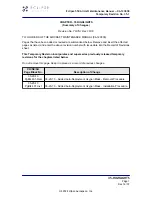
APAX evo user manual
________________________________________________________________________________________________________________________________________________________
Storing, care, maintenance and repairs
Storing the paraglider
Packing the paraglider
The APAX evo can be packed with all the usual methods. To ensure a long life of the profile
reinforcements it is very important that you pack the paraglider carefully. It is therefore
recommended that you pack the APAX evo as shown in the following illustrations.
The leading edge reinforcements (Mylar and Rigifoil system) on the front edge are placed
on top of each other to avoid bending or misshaping them. This method of packing ensures
that the leading edge is treated carefully, which will increase the glider’s life, performance and
launch behaviour.
If the reinforcements have been bent or misshapen, they distort more easily during flight,
creating an altered air inflow which can lead to a loss in performance and changes in flight
behaviour.
The leading edge reinforcements also perform an important function on launch. Therefore,
the less they have been bent, the more easily the glider will inflate and launch.
Figure:
Packing the APAX evo
1.
Spread out the paraglider completely on a smooth surface. Do not drag the
paraglider across any rough surfaces such as gravel or asphalt. This may damage the
seams and surface coating.
2. Start from the center to stack the profiles of each side of the wing on top of each
other.
3. Proceed like this until the wing tip. All the ribs on one side are placed one on top of
one another, so that the leading edges are not bent.
4. Then continue as in the second step, placing the leading edges of the other side on
top of the next until you reach the tip of the glider. Place the concertina bag
underneath the glider which has been folded together, so that the ribs are all lying
along the length of the concertina bag.
Page 33
Summary of Contents for APAX evo
Page 1: ...User manual Version 1 0 Date August 2020...
Page 52: ......










































